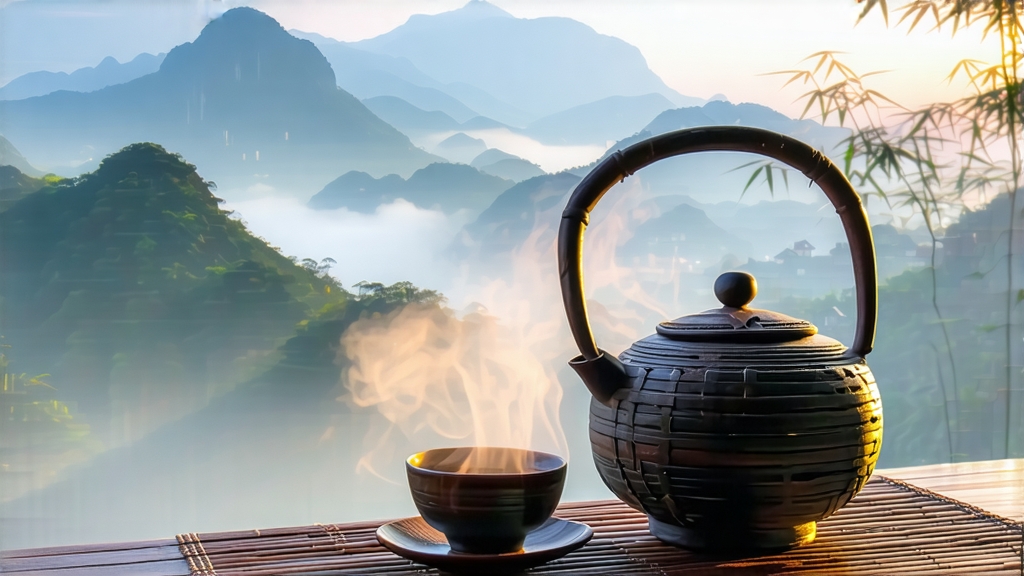
Tucked high above the Sichuan basin, where the first light of dawn spills across a sea of cloud, the Meng Ding range has been whispering the secret of yellow tea for twelve centuries. Among all China’s yellow teas, Meng Ding Huang Ya—literally “Yellow Bud from Meng Ding”—carries the most regal pedigree, yet remains the least known outside the country. This essay invites the global tea lover to discover why the slow, almost forgotten craft of “sealed yellowing” turns a simple green bud into liquid topaz, and how to coax its apricot-sweet soul into a porcelain cup.
-
A leaf born of poetry and empire
The story begins during the Tang dynasty (618-907 CE) when Meng Ding mountain, rising 1 456 m above today’s Ya’an city, was declared a “domain of immortals” by Daoist hermits. Court annals from 724 CE record that local monks presented a “butter-yellow sprout” to Emperor Xuanzong; the infusion’s honeyed fragrance was judged purer than the famed Wu Yi rock oolongs. By the Song era the annual tribute had grown to 360 kilograms, each leaf carried by horseback and barge to Kaifeng under armed escort. When the Qing court switched its allegiance to compressed Pu-erh, Meng Ding Huang Ya slipped into gentle obscurity, surviving only as a monastic beverage. Rediscovered in 1959 by Sichuan tea researchers, it was accorded China’s first “Cultural Heritage Tea” status in 2006, yet annual production still hovers below three tonnes—rarer than silver-needle white tea. -
The micro-world of a single bud
Meng Ding Huang Ya is plucked only between the Qingming festival (early April) and Grain Rain (late April), when the mountain’s thermometer lingers at 12–18 °C. The cultivar of choice is the local “Shu Cha Zao,” a Camellia sinensis var. sinensis bush whose young leaves contain 4.8 % L-theanine and only 12 % catechins—an amino-acid-rich profile that later enables the signature mellow sweetness. Each pluck is a “one bud with one unfolded leaf” standard, 1.5–2.0 cm in length, sheared by fingernail to avoid the bruising that scissors would cause. Pickers work until 9 a.m., when rising humidity risks enzymatic oxidation that would tilt the tea toward green-tea grassiness. -
The choreography of “sealed yellowing”
Unlike green tea’s instant kill-green, Meng Ding Huang Ya undergoes a three-day conversation between moisture, heat and time. The choreography unfolds in five acts:
a. Pan-firing (“Sha Qing”) – 4 minutes at 140 °C in a shallow iron wok, hand-tossed 48 times per minute to destroy leaf-surface oxidase while keeping inner enzymes alive.
b. Initial rolling (“Li Tiao”) – the still-warm leaves are wrapped in a linen cloth and rolled under palm pressure for 6 minutes, breaking 30 % of cell walls to free amino acids without releasing excessive tannin.
c. First piling (“Men Huang”) – the twisted leaves are heaped 8 cm deep inside a bamboo steamer, covered with wet calico, and left in a 28 °C curing room for 24 hours. During this sealed yellowing, chlorophyll degrades into pheophytin, catechins dimerize into theaflavins, and a yellow pigment—flavonol glycoside—emerges, giving the dried leaf its maize hue.
d. Low charcoal baking (“Zao Hong”) – the half-dry leaf is spread on ramie screens 60 cm above a subdued charcoal fire of local oak. The temperature must not exceed 55 °C; artisans judge readiness by listening: when the rustle becomes “like silk slipping over marble,” baking ends.
e. Second piling & final drying – another 12-hour rest inside paper-lined wooden boxes allows residual moisture to migrate from stem to leaf, equalizing water activity to 5 %. A last 20-minute bake at 45 °C sets the aroma, yielding a finished tea that is 95 % dry yet still pliable enough to tie into the traditional “bamboo-leaf knot.”
- From dragon-well to topaz: chemical metamorphosis
Laboratory chromatograms reveal the magic: chlorophyll drops from 1.2 mg g⁻¹ to 0.3 mg g⁻¹, while the ratio of free